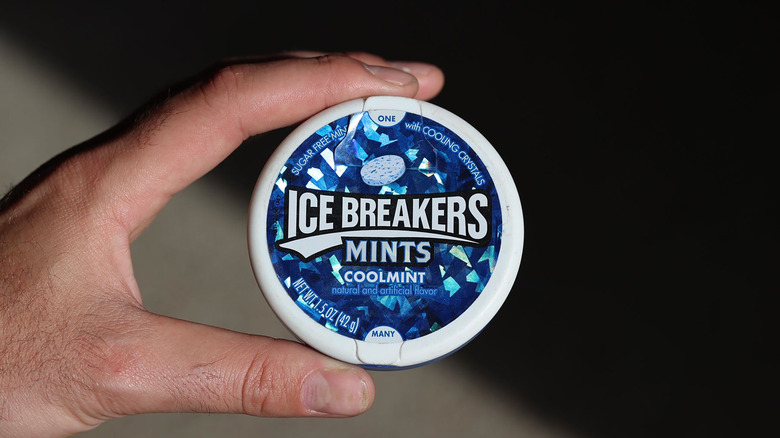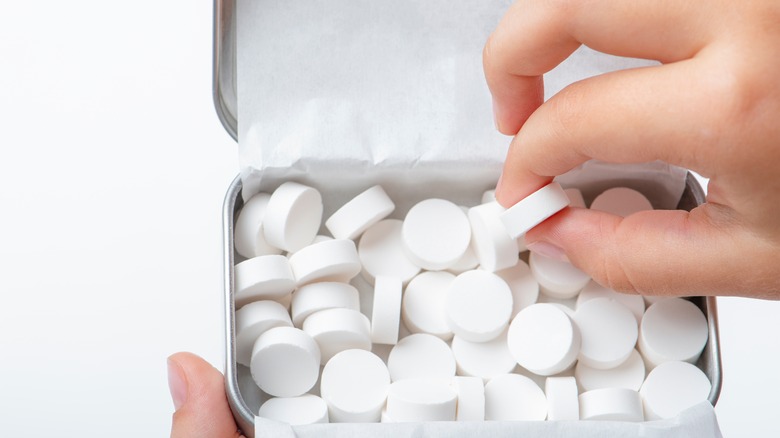What You're Really Sucking On When Having An Ice Breakers Mint
We may receive a commission on purchases made from links.
When you want your mouth to feel (and smell!) fresh, you might be inclined to pop a mint or two. And what could be more tempting than an Ice Breakers Coolmint Sugar Free Mint? These mints are widely available in a travel-sized puck, they're priced right (you can buy a three-pack of the pucks pretty conveniently on Amazon), and — let's be honest — they look snazzy with all those sparkling "cooling crystals" (the blue speckles).
Produced by the famed Hershey Company and highlighted as one of the candy giant's menu of product brands, Ice Breakers Coolmint Sugar Free Mints seem like the perfect, healthy way to treat yourself. After all, they only have five calories per mint and contain no carbohydrates or fat. Yet there are a few ingredients in this popular breath-freshening treat that might give you pause.
To help break down the top Ice Breakers Coolmint Sugar Free Mints ingredients that might be problematic, Health Digest got in touch with Jordan Hill, a west coast-based registered dietitian at Top Nutrition Coaching. With Hill's invaluable assistance, our team was able to pinpoint four ingredients that could make Ice Breakers Coolmint Sugar Free Mints a no-go for you depending upon your lifestyle habits, dietary needs and preferences, and food sensitivities.
Sugar alcohols aren't always so sweet
If you scrutinize your Ice Breakers Coolmint Sugar Free Mints package, you'll see both sorbitol and malitol on the label. In fact, they're at the top of the ingredients list. These are sugar alcohols, and can have unpleasant effects for some consumers. As Jordan Hill explains, sorbitol and malitol are "generally safe to consume." Nonetheless, she cautions that "large quantities may result in a disrupted gut, diarrhea, or imbalance in the gut microbiome."
The issue with sugar alcohols is that they aren't digested in the stomach completely. Instead, they end up being broken down in the large intestine. During this process, they may create unpleasant side effects like generalized stomach discomfort, gas, bloating, and, as Hill mentions, bouts of loose bowels.
Fortunately, such unwanted responses are short-term, as well as more typically associated with consuming larger quantities of sugar alcohols (and an individual mint is fairly small). That said, if you have an existing condition like irritable bowel syndrome (IBS) or you've had sugar alcohol problems in the past, you might be sensitive enough to sugar alcohols to make you take a pass on sugar alcohol-based mints.
A controversial, though FDA-approved, sugar alternative
Ice Breakers Coolmint Sugar Free Mints don't just rely on sugar alcohols to give them a sweet, smooth taste. They also contain aspartame, which Jordan Hill admits may or may not be something to watch out for.
"Aspartame is a sugar alternative and is generally recognized as safe to consume by the FDA," she says. "However, there's been mixed research, and some believe that aspartame may negatively impact various outcomes, such as obesity, type 2 diabetes, autism, and neurodegeneration."
Hill also cites a 2022 study in the International Journal of Molecular Sciences, in which she notes that "aspartame consumption was associated with higher oxidative stress and increased infertility risk." Still, Hill advises that more research is needed on aspartame and its possible health impacts. Therefore, you probably want to stay on the lookout for emerging research as you decide whether or not to eat foods with aspartame.
Colors that look real but aren't -- and may be irritants
Those fun, colorful specks in Ice Breakers Coolmint Sugar Free Mints add to the overall visual appeal of the product. Yet what gives them their bright, eye-catching hue might not be so appealing. Where does all that blue dazzle come from? It's an artificial coloring referred to as Blue 1. Although Blue 1 might sound pretty tame, it has garnered a surprising amount of controversy over the years despite being widely used by food manufacturers.
"Blue 1 is another ingredient generally recognized as safe when consumed in recommended doses but has seen conflicting results when studied in research," Jordan Hill explains. "A review of research done in 2021 points to the negative health potentials of Blue 1 as it relates to its potential impacts on cell damage, DNA damage, and skin irritation."
The 2021 review from Advances in Nutrition that Hill refers to looked at the synthetic dyes known as Blue 1 and Blue 2. After examining reports on the dyes' likely connections to unwanted consumer health effects, the reviewers concluded that due to their potential for toxicities, both food dyes were best replaced by natural substitutes. They added that those natural substitutes might actually bring along health benefits that Blue 1 and Blue 2 did not appear to possess, including being anti-inflammatories and anti-diabetics.
An unexpected (and sneaky) amount of soy in every mint
Soy is the final questionable ingredient in Ice Breakers Coolmint Sugar Free Mints. However, it's so well hidden that you might miss it. Quite honestly, it's not until you get to the list of allergens that you see a "contains soy" remark. Likely, it's from lecithin, which is on the label and is frequently made from soy, per MedicalNewsToday.
This doesn't mean that you'll have a reaction to the soy in Ice Breakers Coolmint Sugar Free Mints, even if you're sensitive to soy in general. As Johns Hopkins Medicine explains, reactions to soy-based lecithin are unusual. That said, they can sometimes happen, and every individual is different.
Consequently, if you've had allergic reactions to very small amounts of soy (or to lecithin that's made from soy) in the past, you might want to exercise caution when eating Ice Breakers Coolmint Sugar Free Mints. Or, you simply might want to seek out a soy-free or lecithin-free mint to give your breath that just-brushed taste and smell.
Swaps for a popular sugar-free mint
Of course, you can still enjoy Ice Breakers Coolmint Sugar Free Mints as desired, especially if you're not worried about any of the product's core ingredients. After all, all the ingredients are technically deemed safe. Plus, they're generally unlikely to cause much acute disruption on your system (at least when those ingredients are consumed in small quantities — which means you shouldn't eat the whole puck of mints in one sitting). But if you're looking for a more natural alternative to your beloved Ice Breakers, be assured that you can find several.
For instance, PUR sells vegan-friendly mints that contain no soy, no artificial flavors, and no aspartame. However, be aware that PUR's mints are created using xylitol. Although xylitol is a sugar alcohol like sorbitol and maltitol, it tends to be better tolerated. (Just be careful if you have a pup in the house: WebMD cautions that xylitol can be very harmful for dogs.) If you're okay with eating real sugar, another alternative minty fresh product is Simply Gum Mints. Boasting just three ingredients (cane sugar, peppermint oil, and calcium stearate), this vegan, kosher swap might be a decently refreshing substitute to swallow.





